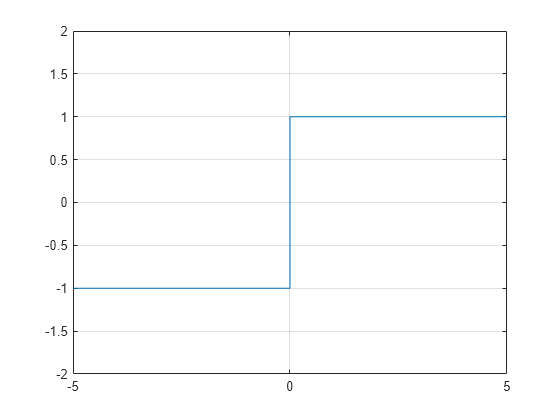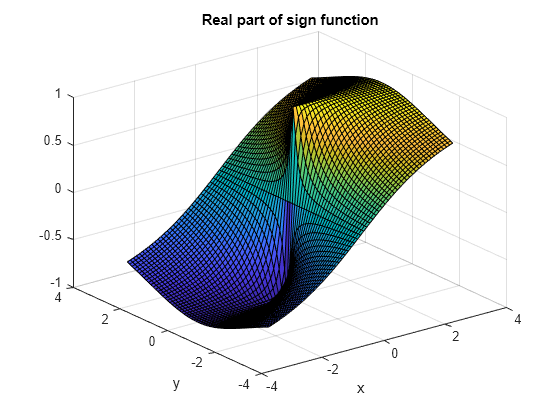sign
Sign 函数(符号函数)
语法
说明
示例
求数字的符号函数。
sign(2)
ans = 1
求向量值的符号函数。
V = [-11 0 1.5 Inf NaN]; sign(V)
ans = 1×5
-1 0 1 1 NaN
求矩阵值的符号函数。
M = magic(3) - 5; sign(M)
ans = 3×3
1 -1 1
-1 0 1
-1 1 -1
求复数的符号函数。
z = 4 - 3*i; sign(z)
ans = 0.8000 - 0.6000i
绘制符号函数,并显示其在过零点处的行为。使用 eps 表示略高于或低于 0 的值。
x = [-5 -eps(1) 0 eps(1) 5];
y = sign(x);
plot(x,y)
ylim([-2 2])
grid on
在 和 范围内绘制符号函数的实部和虚部。
首先,使用 meshgrid 创建 -3 < x < 3 和 -3 < y < 3 范围内的值的网格。然后使用 z = x + 1i*y 根据这些值创建复数。
v = -3:0.1:3; [x, y] = meshgrid(v); z = x + 1i*y;
求出 z 的符号函数的实部和虚部。
s = sign(z); re = real(s); im = imag(s);
绘制实部和虚部。
surf(x,y,re) title('Real part of sign function') xlabel('x') ylabel('y')

figure(2) surf(x,y,im) title('Imaginary part of sign function') xlabel('x') ylabel('y')

输入参数
输入,指定为标量、向量、矩阵或多维数组。
如果 x 的元素是 NaN,则 sign 在输出的对应元素中返回 NaN。
数据类型: single | double | int8 | int16 | int32 | int64 | uint8 | uint16 | uint32 | uint64 | logical | duration
复数支持: 是
扩展功能
sign 函数完全支持 tall 数组。有关详细信息,请参阅 tall 数组。
C/C++ 代码生成
使用 MATLAB® Coder™ 生成 C 代码和 C++ 代码。
此函数完全支持基于线程的环境。有关详细信息,请参阅在基于线程的环境中运行 MATLAB 函数。
sign 函数完全支持 GPU 数组。要在 GPU 上运行该函数,请将输入数据指定为 gpuArray (Parallel Computing Toolbox)。有关详细信息,请参阅在 GPU 上运行 MATLAB 函数 (Parallel Computing Toolbox)。
此函数完全支持分布式数组。有关详细信息,请参阅使用分布式数组运行 MATLAB 函数 (Parallel Computing Toolbox)。
版本历史记录
在 R2006a 之前推出
MATLAB Command
You clicked a link that corresponds to this MATLAB command:
Run the command by entering it in the MATLAB Command Window. Web browsers do not support MATLAB commands.
选择网站
选择网站以获取翻译的可用内容,以及查看当地活动和优惠。根据您的位置,我们建议您选择:。
您也可以从以下列表中选择网站:
如何获得最佳网站性能
选择中国网站(中文或英文)以获得最佳网站性能。其他 MathWorks 国家/地区网站并未针对您所在位置的访问进行优化。
美洲
- América Latina (Español)
- Canada (English)
- United States (English)
欧洲
- Belgium (English)
- Denmark (English)
- Deutschland (Deutsch)
- España (Español)
- Finland (English)
- France (Français)
- Ireland (English)
- Italia (Italiano)
- Luxembourg (English)
- Netherlands (English)
- Norway (English)
- Österreich (Deutsch)
- Portugal (English)
- Sweden (English)
- Switzerland
- United Kingdom (English)